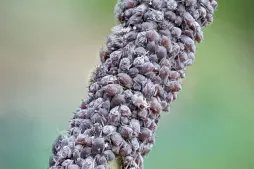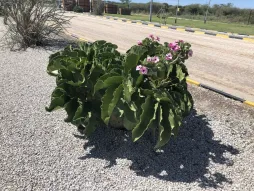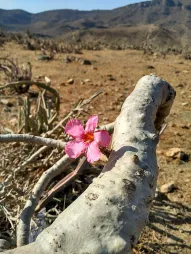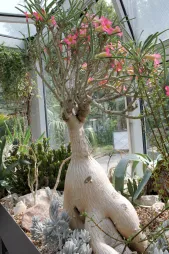Adenium obesum, the desert rose
Few plants can boast of having occupied first place in the top 50. The desert rose (Adenium obesum in Latin) does. We don't know whether its fleshy trunk and blooming flowers inspired Sting to compose his hit Desert Rose. One thing's for sure: this title, which speaks of subtly scented flowers, is a perfect fit for this plant of the Apocynaceae family, which grows from West Africa to the Arabian Peninsula.
How to recognize the desert rose, Adenium obesum?
In the wild, Adenium obesum reaches a height of five meters. In our latitudes, this semi-succulent shrub with an upright habit rarely exceeds 1.5 m in pots.
The desert rose is a caudex plant. Its swollen, fleshy trunk serves as a water reservoir. Covered in gray bark, it branches at the top.
The semi-evergreen foliage falls during the dry season. Adenium obesum then reveals its tortuous branches. For the rest of the year, the branches are crowned with sessile leaves. They grow in rosettes directly on the branch, without stalks or peduncles.
The succulent, oval to lanceolate leavesare smaller than those of adenium dhofarense. They are up to 15 cm long and 8 cm wide. Blades are shiny green on the upper side and glaucous green on the underside.
Flowering takes place in spring, before the first leaves appear. The desert rose is adorned with trumpet-shaped flowers. Composed of five rounded lobes with wavy margins, they measure up to six centimetres in diameter. Their color varies according to variety. Often pink, white or red, they can also be purple, black or yellow in certain hybrids.
Adenium obesum is toxic. Its sap contains alkaloids, a substance highly dangerous to humans and animals if ingested. Keep your desert rose out of the reach of your dog and especially your cat.
Our maintenance tips
You can propagate your Adenium obesum by sowing or cutting. Sowing produces a plant identical to the mother plant. With cuttings, your new specimen will not develop a caudex.
Watering
Water your Adenium obesum when the soil has dried deeply. Use water at room temperature to avoid damaging the roots. If you can, use rainwater or non-calcareous water.
Never leave water standing in the saucer or planter, as this will rot the roots.
Spray
Your adenium obesum hates wet foliage. You must not mist the plant.
Repotting
Every spring, repot your Adenium obesum to give it more space.
Get a pot with holes larger than the root ball of your Adenium obesum.
Adenium obesum appreciate a light, draining substrate. You can plant your specimen in potting soil for cacti and succulents. You can also make your own growing medium by mixing equal parts potting soil and a draining material such as sand, perlite or pozzolan.
Place a layer of substrate at the bottom of the pot. Plant your Adenium obesum in the center. Then add potting soil. In young plants, the caudex grows better when buried. If your plant is less than four years old, bury two-thirds of it. If it's older, you can leave it on the surface.
Water generously to facilitate rooting.
Fertilization
To promote the growth of your Adenium obesum, apply fertilizer in spring and summer.
Use a cactus and succulent or Mediterranean plant fertilizer to encourage the growth of your Adenium obesum.
Prune
Remove wilted flowers as and when they appear, to encourage the emergence of new inflorescences.
Seedling
Prepare a light, draining substrate, for example 50% potting soil for cacti and succulents, 25% pozzolana and 25% sand. Pour your mixture into plastic cups.
Plant your seeds, covering them with two to three centimetres of substrate. You can put several seeds in the same pot.
Sowing is done in the air. Place your pots in a mini-greenhouse or cover them with a bottle or translucent plastic bag.
Mist the substrate regularly to keep it moist. Don't forget to air the pots a few minutes a day.
Cutting
Cutting is carried out during the strong growth phase, generally in spring and early summer.
Locate a healthy, flowerless branch. Cut a section with several leaves about 10 centimetres long. Use a clean, sharp tool to facilitate healing.
Leave your cutting to dry for 24 to 72 hours, until a callus forms.
Obtain a pierced terracotta pot. This material promotes uniform drying of the substrate and reduces the risk of root rot. Pour a bed of clay balls or gravel in the bottom. If the hole is too large and the marbles escape, fill it with a pebble.
For the substrate, prepare a mixture of one-third soil, one-third potting compost and one-third sand. Line the pot with it. Plant your cutting in the center and press down.
Place your succulent in a room where the temperature doesn't fall below 18 degrees. Find a bright spot away from direct sunlight, behind a curtain for example.
Diseases / Threats
Information
| Family | Apocynaceae - Apocynaceae |
| Type | Desert rose - Adenium |
| Species | Adenium obesum - Adenium obesum |
| Lifecycle | Perennial |
| Foliage | Deciduous |
| Exposure | |
| Substrats | |
| Planting methods |
In pots In tubs Bucket |
| Categories | |
| Tags |
Flowery Fritillary Toxic |
| Origins |
West Africa East Africa Central Africa |
| Hardiness (USDA) | 12a |
| Leaf color |
|
| Flower colors |
|
Discover plants from the same family
























